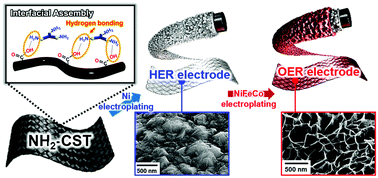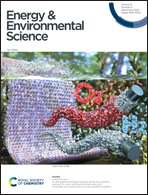A carbonization/interfacial assembly-driven electroplating approach for water-splitting textile electrodes with remarkably low overpotentials and high operational stability†
Abstract
A key requirement for realizing highly efficient commercial water-splitting devices is to develop non-noble metal-based electrodes that can generate a large amount of hydrogen fuels with low overpotentials and high operational stability. Herein, we introduce high-performance water-splitting electrodes (WSEs) with extremely low overpotentials and unprecedently high operation stability via a carbonization/interfacial assembly-induced electroplating approach. To this end, silk textiles were first converted to carboxylic acid-functionalized conductive textiles using carbonization and subsequent acid treatment. Then, amine linkers were assembled onto the conductive textiles to achieve favorable interfacial interactions with electrocatalysts. For a hydrogen evolution reaction (HER) electrode, Ni was electroplated onto the interface-modified textile, while to prepare an oxygen evolution reaction (OER) electrode, NiFeCo was additionally electroplated onto the Ni-electroplated textile. These HER and OER electrodes exhibited extremely low overpotentials in alkaline media (12 mV at 10 mA cm−2 for the HER and 186 mV at 50 mA cm−2 for the OER), outperforming the conventional non-noble metal-based electrodes. Additionally, the overall-water-splitting reaction of full-cell electrodes was stably maintained at a remarkably high current density of 2000 mA cm−2 and a low cell voltage of 1.70 V. We believe that our approach can provide a basis for developing commercially available high-performance WSEs.



 Please wait while we load your content...
Please wait while we load your content...